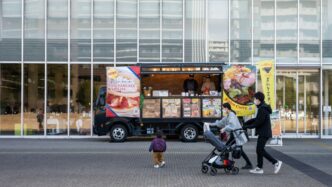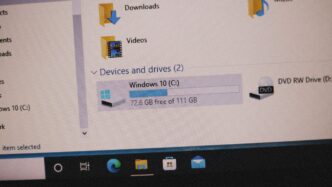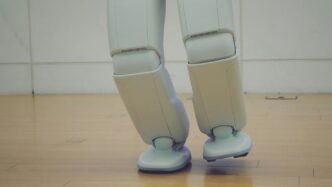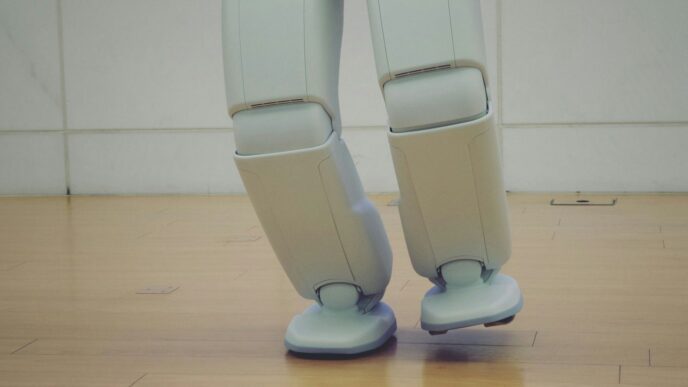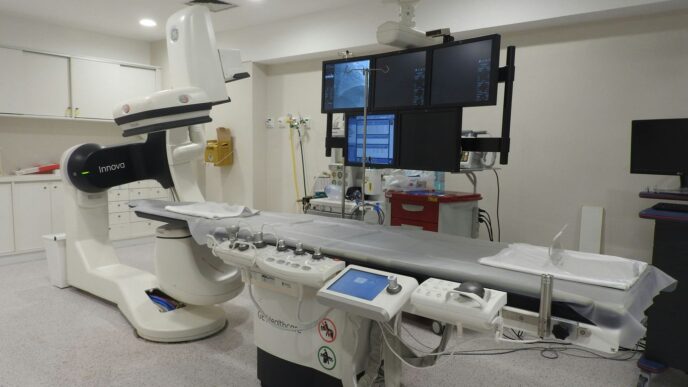Jersey City Welcomes Robot Uber Eats
A New Era of Food Delivery
Get ready, Jersey City! Something new is rolling onto our sidewalks. Uber Eats has officially launched its autonomous delivery robot program right here, marking a first for New Jersey. This isn’t just about getting your favorite meals a little faster; it’s a peek into how we might get our goods in the future. We’re talking about small, smart robots bringing your takeout right to your door. It’s a big step, and it’s happening now.
Autonomous Vehicles Take to the Sidewalks
These aren’t your typical delivery cars. We’re seeing compact, four-wheeled robots, about the size of a carry-on suitcase, making their way around town. They move at a safe pace, up to five miles per hour, and are designed to handle sidewalks and crosswalks. They’ve got sensors to spot obstacles and can even deal with different kinds of weather, so your food should arrive no matter what.
Partnering for the Future of Mobility
This launch is a collaboration between Uber Eats and a company called Avride. They’ve been testing these robots in other cities, and now Jersey City is part of the plan. It shows how different companies are working together to figure out the best ways to use this new technology. The city’s mayor has even spoken about embracing these innovations, looking at how to best use them responsibly while keeping the community in mind.
How Robot Uber Eats Works
So, you’re curious about how these little sidewalk robots actually get your food from the restaurant to your doorstep? It’s pretty straightforward, actually. When you’re placing your order through the Uber Eats app, and you’re in a zone where the robot service is active, you’ll see an option to choose your delivery method. It’s not just the usual human courier anymore; you might get to pick a robot!
Choosing Your Delivery Method
Once you’ve picked out your favorite meal from a participating restaurant, just head to checkout in the Uber Eats app. If robot delivery is available for your order, you’ll see it as an option right alongside the traditional delivery driver. It’s as simple as tapping a button to select the robot. This gives you a choice in how your food arrives.
Tracking Your Autonomous Order
After you’ve confirmed your order with the robot option, the app will keep you in the loop. You can watch the robot make its way to you in real-time, just like you would with a human courier. You’ll get notifications when it’s getting close and when it has officially arrived at your location. No more guessing when your food will show up!
Unlocking Your Robot’s Cargo
When the robot gets to you, it’s time to grab your food. The robot’s compartment is secure, so you don’t have to worry about anyone else getting into it. You’ll use the Uber Eats app itself to unlock the cargo bay. Just follow the prompts in the app, and your food will be ready for you to pick up. It’s a pretty neat way to get your meal without needing to interact directly with a driver if you don’t want to.
The Technology Behind Robot Uber Eats
So, how exactly do these little food-carrying robots work? It’s pretty neat, actually. Uber teamed up with a company called Avride, and they’ve put together some smart sidewalk robots. These aren’t just remote-controlled toys; they’re packed with tech to get your food from the restaurant to your door safely.
Avride’s Autonomous Sidewalk Robots
These robots are about the size of a carry-on suitcase, which makes them easy to spot but not too intrusive. They have four wheels and can move along sidewalks at a decent clip, up to five miles per hour. That’s about as fast as a brisk walk, so they’re not going to be zipping past you unexpectedly. Each one can carry a good amount of food, up to 55 pounds, which is enough for a few big orders or even some larger pizza boxes. They’ve got these swappable batteries that give them a life of up to 12 hours, meaning they can keep working pretty much all day.
Navigating Urban Environments
Getting around a busy city like Jersey City isn’t simple, but these robots are built for it. They use a bunch of sensors – things like LIDAR, cameras, and ultrasonic sensors – to see what’s around them. These sensors can detect obstacles from as far as 200 feet away, which is pretty impressive. They’re programmed to recognize traffic lights and can handle crowded sidewalks without bumping into people. They’re also designed to follow traffic rules, so they should be predictable and safe for pedestrians and other sidewalk users.
Weather-Resistant and Safe Operations
Don’t worry about your lunch getting rained on. These robots are built to handle different kinds of weather, so they can keep making deliveries rain or shine. Safety is a big deal, too. The cargo compartment where your food sits is secure and can only be opened by you using the Uber Eats app. Plus, the cameras on the robots are set up to blur faces and license plates, so they’re not capturing personal information as they roll around. The data they do collect, like where they pick up and drop off orders, is anonymized and used just to make the robots work better.
Participating Restaurants and Service Area
Initial Restaurant Partners
Right now, you can get your food delivered by a robot from a select group of local spots. It’s a pretty cool mix, including places like the Michelin-rated Jiangnan, Rumi Turkish Grill, and Gulp. We’ve also got Downtown Yogurt Jersey City, Amiya, and Short Grain on the list. Uber Eats and Avride are planning to add more restaurants soon, so keep an eye on the app for updates. It’s a good way to try out some new places or stick with your favorites while checking out this new tech.
Service Hours and Geographic Limits
For now, the robot deliveries are running daily from 11 a.m. to 9 p.m. The current service zone is pretty focused on downtown Jersey City. Think the areas from Hamilton Park all the way to Historic Downtown and over to the Waterfront. It’s about a one-square-mile area, which makes sense for the robots’ optimal range. They’re designed to handle shorter trips efficiently, so this initial zone is a smart start.
Future Expansion Plans
This is just the beginning, though. Uber Eats and Avride have big plans to grow this service. They’re looking to expand the operational territory beyond the current downtown area. The goal is to cover more of Jersey City and eventually other neighborhoods. They’re also aiming to increase the number of robots on the streets, with plans to have hundreds operating by the end of 2025. So, while the service is limited now, expect it to become much more widespread pretty quickly.
Mayor’s Support for Robot Uber Eats
Jersey City is really leaning into the future, and Mayor Steve Fulop is right there leading the charge. He’s made it clear that when it comes to new tech like these delivery robots, Jersey City isn’t going to be the one to hit the brakes. Back in August, he posted on X (you know, the platform formerly known as Twitter) about being "in the loop" and actively looking into how the city can "responsibly utilize" these autonomous helpers.
He pointed out that while other places, like New York City, have put the kibosh on them, Jersey City is taking a different path. "On the JC side we are not sure that banning is the best approach," he wrote, adding that the city is "now exploring options on regulations/parameters." This shows a real willingness to figure things out rather than just saying no.
Embracing Technological Innovation
Mayor Fulop’s administration has a history of looking at new ideas, and this is just another example. He believes that embracing technology can bring good things to the community.
Exploring Regulatory Frameworks
It’s not just a free-for-all, though. The city is actively working on setting up the rules of the road, or rather, the sidewalks. They’re figuring out the best way to let these robots operate safely and effectively.
Enhancing Community Convenience
Ultimately, the goal is to make life a little easier for everyone in Jersey City. These robots are seen as a way to potentially speed up deliveries and make them more reliable. The Mayor mentioned that the community "would embrace technological innovation and provide enhanced business opportunities and convenience for residents." It’s all about finding that balance between new tech and making sure it works for the people living here.
Privacy and Security Features
Data Protection Measures
When you order food via a robot, your personal information stays protected. The robots themselves don’t keep records of things like your credit card number or your home address. That information stays with Uber Eats, just like any other order. The robots are programmed to only know where to pick up the food and where to drop it off. This keeps your private details out of the delivery process itself.
Anonymized Sensor Data
These little robots are equipped with sensors and cameras to help them get around safely. But don’t worry, they’re not spying on anyone. Any information gathered by these sensors, like what the cameras see, is anonymized. This means it’s stripped of any personal identifiers. It’s used strictly to help the robots learn and improve their routes and how they operate. For example, they’ll blur out faces and license plates they might see on the street. This way, the technology gets smarter without collecting anything that could point back to you or anyone else.
Secure Unlocking Mechanisms
Getting your food from the robot is simple and secure. Once the robot arrives at your location, you’ll get a notification. Then, you’ll use the Uber Eats app to unlock the robot’s cargo compartment. It’s a digital key, so only the person who ordered the food can open it. This prevents anyone else from grabbing your meal. It’s a straightforward process designed to give you easy access to your order while keeping it safe until you get it.
The Broader Impact of Robot Uber Eats
It’s pretty wild to think about how fast these little robots are becoming a normal sight in cities. They’re not just a novelty anymore; they’re starting to change how we get our food and other stuff.
Scaling Operations Nationwide
Uber Eats and its partner Avride aren’t just testing the waters in a few spots. They’re planning to roll out hundreds more of these delivery robots across the US by the end of 2025. This means that if you’re not seeing them yet, it’s likely only a matter of time. They’ve already launched in places like Austin and Dallas, Texas, and now Jersey City is getting in on it. The goal is to make this kind of delivery available in many more cities, making it a common option for people everywhere.
Reducing Delivery Fees and Increasing Reliability
One of the big promises of using robots is making deliveries cheaper and more dependable. Think about it: robots don’t need breaks, don’t get stuck in traffic jams (at least not in the same way we do), and they can operate for long hours. This could mean lower delivery fees for us customers. Plus, they’re programmed to follow city rules and navigate sidewalks, which should make deliveries more predictable. No more wondering if your driver is lost or got held up.
- Faster delivery times on short urban routes.
- Consistent service regardless of weather or driver availability.
- Potential for lower costs passed on to consumers.
The Future of Autonomous Delivery Services
What we’re seeing with Uber Eats and these robots is just the beginning. The whole idea of autonomous delivery is a massive opportunity, potentially worth trillions in the US alone. Companies are investing heavily in this technology. Uber itself used to have its own self-driving car division but has since shifted to partnering with companies like Avride. This move shows a strategy to bring autonomous tech to market through collaboration. It’s not just about food anymore either; these robots can handle groceries and small packages, opening up a whole new world of what can be delivered autonomously right to your doorstep.
What’s Next for Robot Deliveries?
So, there you have it. Robot food delivery is officially a thing here in Jersey City. It’s kind of wild to think about, right? We’ve seen these things in movies, but now they’re actually rolling down our streets, bringing us our burgers and fries. Mayor Fulop seems on board, which is a good sign, and Uber says they’re planning to add more robots and expand the delivery area. It’ll be interesting to see how this all plays out. Will everyone start ordering from robots, or will people stick with human drivers? Only time will tell, but one thing’s for sure: the way we get our food is changing, and Jersey City is right in the middle of it.

